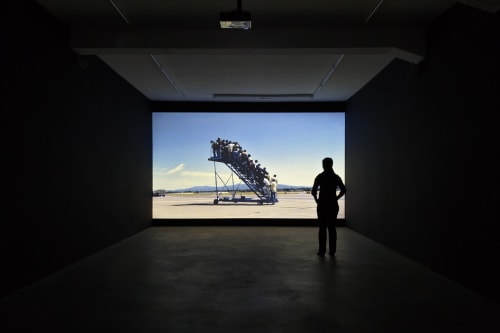Migration and identity, as well as the consequences of social, political and cultural changes in everyday life are the central themes in the work of Albanian artist Adrian Paci, who has been living in Italy since the end of the nineties.
In his early works, it is the artist’s experiences with migration and his close familiar environment, which can be defined as contexts for his videos, installations, sculptures, photographs and paintings. Beyond this background, the artist has abstracted his questions and motifs by integrating amateur actors. A characteristical feature in Paci’s artistic approach is his switching between the use of different media such as video, painting, sculpture and photography, and his telling of situations through a cinematic perspective. His works emphasize little gestures, create gaps referring to the micro- and macrocosms of social spaces. In his famous video installation Turn on (2004), men appear as individuals before being portrayed as part of a collective, and vice versa. The close-up photograph of a face particularly expresses the uniqueness and vulnerability of human life. The element that interconnects the group is cultural identity, symbolised by a common action, and which every human being experiences through his socialization (experiences, scope of memories and social context).
In his new video, Centro di Permanenza Temporanea (2007), the central setting is an airport. A crowd of people is patiently moving towards an aircraft boarding staircase. They form a queue while we can observe planes taking off and landing in the background. Gradually, the stairs fill up with migrant men and women. They have to squeeze together in order to make space for the people moving up. The peoples’ faces mirror their yearning for the fulfilment of a humane life without discrimination and cultural uprooting. The camera slowly circles around the free-standing staircase. Where is this flight bound for? Nowadays airports are places of transit, where global mobility is apparent. For the majority of passengers, such as business men and tourists, the airport is a necessary functional space between takeoff and landing. Here, the travellers could be however deported migrants being sent back to their country of origin. In its title, the video Centro di Permanenza Temporanea (2007) in fact refers to the temporary camps for illegal immigrants (sans papiers), which are very common in Italy.
The invitation shows a cut-out of a newspaper photo with a stream of people, men crowding closely together and waiting. A man looking into the photographer’s camera forms the centre of the photograph. Yet it is on the left side of the photograph that another man’s head has been marked with a red circle. Why is this man graphically distinguished and not someone else? Not only in Europe are migrant movements a current phenomenon with regard to foreign affairs. The problem is particularly present in border regions and can be followed in the media. In this context, legally established selection processes represent a human problem, as they cannot always take into account the destiny of every individual. In contrast to that, Paci focuses in his forty-minute video Klodi (2005) on the real-life circumstances of an Albanian immigrant. He films a man who gives an account of his experiences as an illegal immigrant, of his deportation from the United States and of his children who stayed there.
 Adrian PaciCentro di Permanenza temporanea, 200716:9 video projection (NTSC), 5.30 min, color, soundEd. 6/6
Adrian PaciCentro di Permanenza temporanea, 200716:9 video projection (NTSC), 5.30 min, color, soundEd. 6/6 Adrian PaciIt was not a performance, 2007 / 2001C-Print150 x 125 cm (59.1 x 49.2 in.)Ed. 1/6 + 2 AP
Adrian PaciIt was not a performance, 2007 / 2001C-Print150 x 125 cm (59.1 x 49.2 in.)Ed. 1/6 + 2 AP Adrian PaciKlodi, 2005Single channel video, projection or monitor, 40 min., color, soundEd. of 5 + 2 AP
Adrian PaciKlodi, 2005Single channel video, projection or monitor, 40 min., color, soundEd. of 5 + 2 AP Adrian PaciBelieve me I'm an Artist, 2000Single channel video, projection or monitor, 6.54 min., color, soundEd. of 5 + 2 AP
Adrian PaciBelieve me I'm an Artist, 2000Single channel video, projection or monitor, 6.54 min., color, soundEd. of 5 + 2 AP







